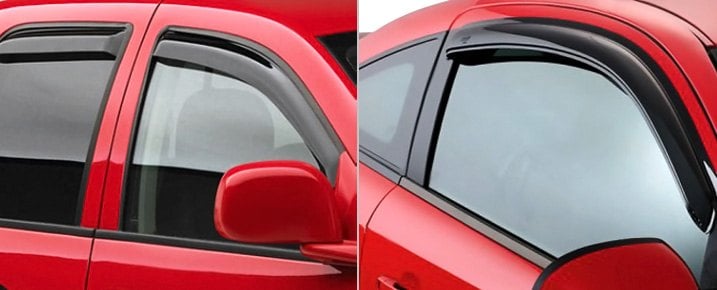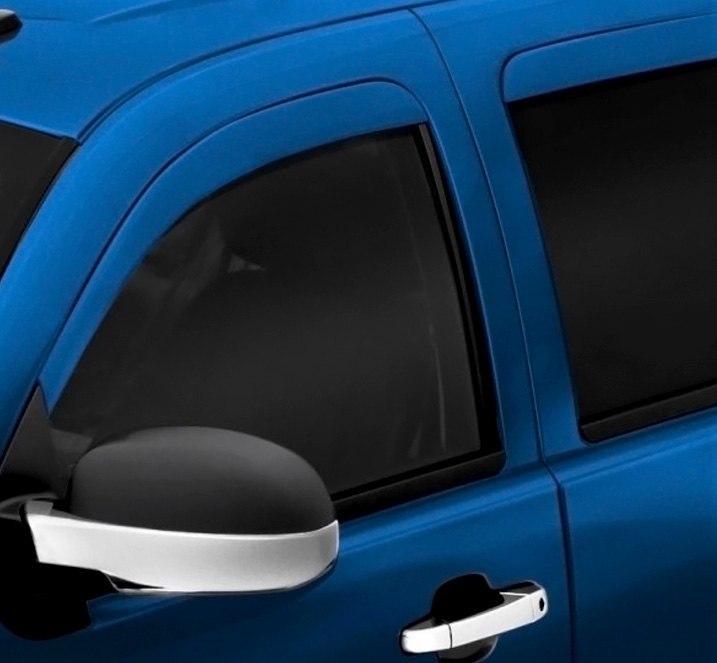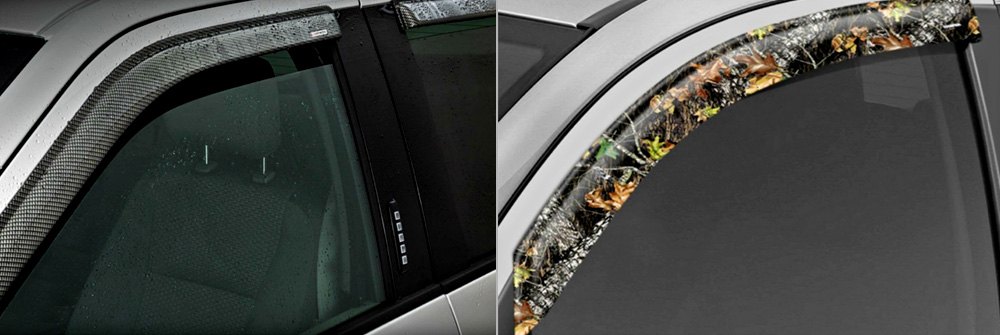How To Install Car Window Deflectors
Pelting Guards, too known as wind deflectors, window deflectors, or window visors, improve your vehicle's aerodynamics when the windows are down, reduce annoying air current noise, shield you from rain spray, and allow windows to be left cracked in a parking lot without giving notice to potential thieves. Going frontward, we'll refer to them every bit "deflectors" in this article.

Hither, nosotros'll cover the piece of cake steps involved with installing both types of deflectors: In-Channel and Stick-On. Ever follow the specific instructions from the manufacturer whose production you are installing. Nosotros as well invite you to read our related commodity "Pelting Guards: In-Channel vs. Stick-On" for more than details on the two types, specific products offered, and advantages of each mode.
In-Channel Deflectors
In-aqueduct window deflectors are made with a thin flange that slots into a automobile door's upper window channel. Equally you lot brainstorm this installation, lay out all the pieces and exist certain that you lot have the correct deflector for each door (commuter's side forepart, passenger side rear, etc.) Start past lowering the window and tucking the flange all the way upwards into the window channel, outset at the forepart. Some deflectors rely on tension to maintain a snug fit once installed, and these literally "snap" into place within the window aqueduct. Take your time and work each deflector as far into the channel as possible.
Follow the detailed instructions written as captions under each analogy below.
It's important to note that many in-channel deflectors utilise a minor amount of double-sided tape for assistance in staying in place in one case installed. If yous've got an in-channel deflector that uses record, be sure to test fit it into the window channel starting time - because once information technology's installed with the tape, removal becomes more difficult.
Once you're satisfied the fit is good, remove the deflector from the window channel, clean the surface area, and entirely remove the adhesive backing strips. And so, tuck the deflector flange back up into the window channel all the style. Raise the window upward completely to keep pressure on the adhesive until it fully bonds in place. Private manufacturers will specify an amount of time that windows should remain upwardly to ensure everything sets properly. If they don't, 24 hours is an advisable menses of fourth dimension.
NOTE! From our experience, a mutual reason why in-channel deflectors fall out of place is the failure to exit the windows up and the vehicle undisturbed for the recommended corporeality of time! It is all-time if the vehicle is allowed to sit. If y'all must drive, exist certain that you and your passengers exercise NOT lower the windows! This is both to allow the adhesive (if used) to cure, and to allow the plastic deflector to adjust to the shape of the window channel.

When information technology comes to in-aqueduct current of air deflectors, we've got the WeatherTech In-Channel Side Window Deflectors (choose light or dark tint), Putco In-Channel Chemical element Window Visors (tinted or chrome), Stampede Snap-Inz Sidewind Deflectors (tinted), Lund In-Channel Ventvisor Aristocracy Window Deflectors (tinted), and GTS In-Channel Ventgard Snap Window Deflectors (clear or tinted) only to name a few.
If you adopt a low profile deflector that sits more flush to the door panels, we've got the AVS Factory Colour Lucifer In-Aqueduct Low Contour with surfaces available in a variety of auto manufacturer pigment codes. Or, cull the low-profile version with heavily tinted articulate plastic.
Stick-On Deflectors
Stick-on deflectors are attached with tape to the outside of the vehicle merely to a higher place the window channel - either on the door frame for side window deflectors, or the roof for rear window deflectors. If your side windows are frameless, then yous'll be attaching the deflectors directly to the roof. Because in that location'southward no window aqueduct to use equally a guide, stick-on deflectors require more "eyeball" piece of work to ensure they line up properly - especially when iv doors are involved.
Follow the detailed instructions written as captions under each analogy below.
Starting time by cleaning the vehicle where the agglutinative tape will be practical using a cleaner/degreaser and water. Buff any window trim moldings that volition come in contact with the deflector using a light scuff pad. Clean the entire area, either using isopropyl alcohol, "paint prep", or "surface preparation" pads which may be included in your kit. This step removes wax and other contaminants that might forestall the tape from adhering properly.
To make test fitting easier, peel a small portion of the backing strip away from the tape at both ends of the window visor. Place the deflector in the position where it will be mounted, adjustment it with any window trim that's present. Adjust the position of the deflector until yous're satisfied, then gently press on the ends so the peeled agglutinative continue the deflector in identify (make sure the ends of the bankroll strips stick out visibly, because you lot'll need to grab on to them in order to pull the tape all the mode off).
When you're ready, remove all remaining backing record by pulling on the terminate strips that were left sticking out during the previous step. Every bit you peel the rest of the backing strip away, employ force per unit area on that spot as you go. When all the backing has been removed, rub your hand dorsum and forth over the deflector in gild to continue applying pressure level to all areas a picayune longer. One time bonding is consummate, test for proper adherence by attempting to wiggle the deflector; it should not flex. Follow the manufacturer's guidelines about non washing the vehicle for a flow of time after installation.

If record-on current of air deflectors are your preference, The Stampede Tape-Onz Sidewind Deflectors (available in false carbon fiber and camo patterns), AVS Record-On Aerovisor Window Deflectors, Putco Tape-On Element Window Visors (tinted or chrome finish), EGR Record-On Window Visors (tinted or matte black), Rugged Ridge Tape-On Window Deflectors (tinted, false carbon fiber, matte black), RI Tape-On Window Visors (tinted or chrome), and GTS Tape-On Ventguard Sport Window Deflectors (tinted or simulated carbon fiber) amidst many others.
If you lot prefer a low contour deflector that sits more flush to the door panels, nosotros've got the AVS Tape-On Low Contour Ventvisor Window Deflectors (tinted or matte black). If y'all prefer a pick of machine manufacturer colors, there'south the Factory Color Match version.

Rain guards / window deflectors offering you and so many advantages. We are certain you're going to get a lot of enjoyment out of the deflectors we offering - no matter which ones you choose. They're made from non-corrosive materials, and will remain attractive and functional for a long time. One of their biggest advantages is that yous don't need to pay someone the large bucks to put them on - you Tin can perform the installation yourself. We trust that this brief prepare of instructions gives y'all the confidence to move ahead with the window deflectors yous want!
March 02, 2016
Source: https://www.carid.com/articles/how-to-install-rain-guards-in-channel-and-stick-on.html
Posted by: martinthessalky.blogspot.com

0 Response to "How To Install Car Window Deflectors"
Post a Comment